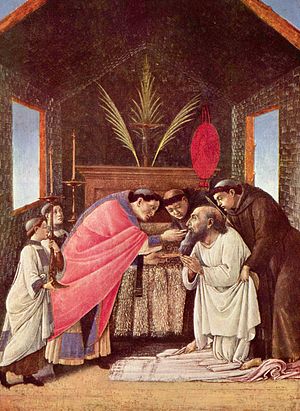Year 1494–1495 Artist Sandro Botticelli Created 1494–1495 | Medium Tempera on panel Dimensions 34 cm x 25 cm | |
 | ||
Location Metropolitan Museum of Art Genres Christian art, History painting Periods Early renaissance, Florentine painting Similar Sandro Botticelli artwork, Tempera, Early renaissance artwork | ||
The Last Communion of St. Jerome is a painting by the Italian Renaissance master Sandro Botticelli, finished around 1494-1495. It is housed in the Metropolitan Museum of Art, in New York City.
The small picture is inspired to one of the three apocryphal letters of Eusebius, according to which, before dying, St. Jerome received the Last Communion from St. Eusebius himself. The choice of this scene, far less frequent than the usual depiction of St. Jerome in his studio, has been connected to Savonarola's predication in Florence at the time the work was executed; the latter's commissioner, identified by some scholars as the rich merchant Francesco del Pugliese, would be in fact a followed of the Ferrarese preacher.
The topic was depicted by the baroque Bolognese painter Agostino Carracci in his painting now at the Galleria Nazionale of Bologna, and also by the Baroque painter Domenichino in a painting in the Vatican Museum.
